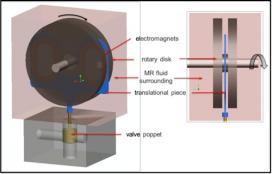CCEFP Researchers Evolve High Performance MR Valve Actuation
Researchers at the National Science Foundation’s (NSF) Engineering Research Center (ERC) for Compact and Efficient Fluid Power (CCEFP) at the University of Minnesota have developed and tested a novel, high-speed valve actuation system that is capable of proportional and bi-directional operation.
The innovative valve actuation system shows especial promise for applications requiring large flow rate valves. CCEFP’s proof-of-concept actuator uses magnetorheological (MR) fluid as the coupler between the rotary and translational pieces. It can be used to actuate poppet or spool type valves and does not require a pilot pressure source. Multiple actuators and valves can be compactly stacked on a single rotating shaft. With an improved coil design, the valve will afford a faster response while using less power per switch.
A simulation model for the MR valve actuation system accurately predicted the measured response. In testing, the new MR valve actuation system experimentally achieved a 1.5 millimeter (mm) stroke in 4.5 milliseconds (ms)—equivalent to the design target of 100 Liters per minute (L/min) at five barometers (@5bar). The system also scales favorably—achieving a 7 mm stroke in 10ms—enabling the actuator to be used in large flow rate valves. The validated model is being used to optimize the design.


